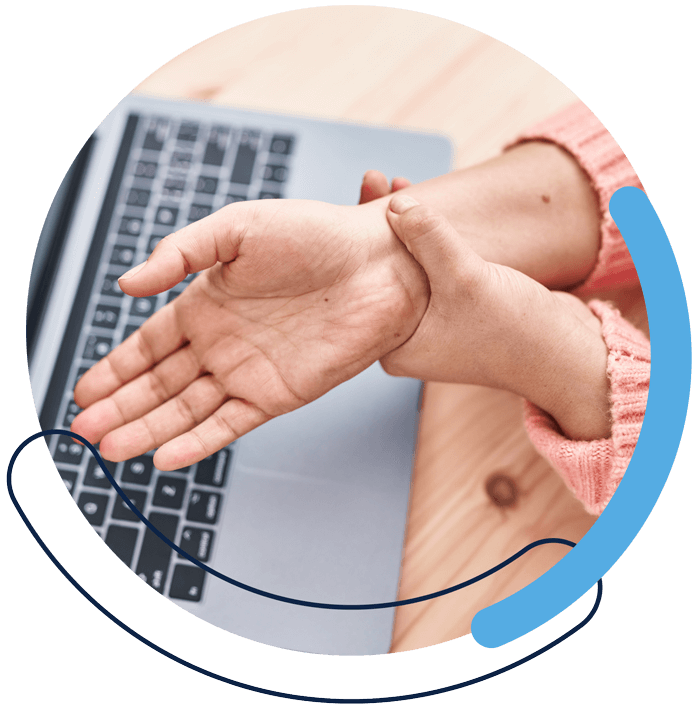De Quervain’s Tenosynovitis
De Quervain’s Tenosynovitis
Recognising the Symptoms , Signs and Treatments
De Quervain’s Tenosynovitis
Pain and tenderness on the thumb side of your wrist? It could be De Quervain’s tenosynovitis. This condition causes inflammation of tendons (tendinitis) near the base of your thumb. I specialise in diagnosing and treating De Quervain’s, offering a range of solutions to relieve your pain and restore function.
Understanding De Quervain’s Tenosynovitis
De Quervain’s affects the tendons that help you extend your thumb. Here’s what you need to know:
- Symptoms: Pain and swelling near the base of the thumb, sometimes with a catching or snapping feeling when moving the thumb.
- Causes: Overuse of the thumb and wrist, often with repetitive motions.
- Treatment: Includes rest, splinting, anti-inflammatory medication, and in some cases, injections or surgery.
Don’t let wrist pain limit your hand use. Let’s determine if De Quervain’s is the cause and find the best treatment plan for you.

De Quervain’s Tenosynovitis FAQs
De Quervain’s (often pronounced duh-KARE-vains) is a condition involving irritation and swelling of the tendons on the thumb side of your wrist. These tendons travel through a tunnel-like sheath, and when they swell, it causes pain and tenderness.
Most of the time, it’s from repetitive movements involving your thumb and wrist, especially forceful twisting or gripping. New moms are quite susceptible due to how they often lift their babies, but it can stem from work activities, sports, hobbies – anything that repeatedly stresses that area.
It usually starts with pain and tenderness at the base of your thumb, specifically near the wrist. Swelling in that area is common, and you might notice a “catching” or “snapping” sensation when you move your thumb.
Sometimes! For milder cases, resting the affected wrist, avoiding overuse, and simple at-home measures can make a big difference. However, if the pain and swelling are severe, or it fails to improve after a week or so of rest, it’s crucial to seek medical help.
Gentle stretching and range-of-motion exercises can help maintain flexibility in the affected wrist and thumb. It’s best to have a hand therapist or your doctor guide you to avoid exercises that further irritate the tendons.
A lightweight splint that immobilizes your thumb and wrist is frequently recommended. This protects the inflamed tendons and encourages healing. Splints are especially helpful while sleeping when we can sometimes accidentally bend our wrists.
Both can be helpful! Ice in the early stages is better for reducing acute inflammation and swelling. Later on, gentle heat might soothe the tendons and enhance circulation to promote healing. Try alternating sessions.
Over-the-counter pain relievers and anti-inflammatories like ibuprofen or naproxen can offer temporary relief and reduce swelling. In some cases, your doctor might prescribe a stronger pain medication.
Yes, often it’s highly effective. Injecting a steroid and numbing medication directly at the site of inflammation significantly reduces swelling of the tendon sheath. This allows the tendon to glide smoothly again, easing pain and restoring movement.
A hand therapist can design a safe exercise program, teach you ergonomic ways to reduce wrist strain, and possibly use techniques like ultrasound to promote healing. Therapy is very helpful alongside other treatments, and also after any injections or surgery.
It’s rarely needed, thankfully! Most cases respond well to rest, splinting, medications, and sometimes targeted injections. However, if it fails to improve, a minor surgical procedure can release the narrowed tunnel for the tendon, easing the pain.
Despite both causing pain around the wrist and thumb, de Quervain’s is specifically about tendon inflammation, while arthritis refers to a disease affecting the joints themselves. Your doctor can determine the right diagnosis with an examination.
Unfortunately, even with successful treatment, some people experience occasional flare-ups. Identifying activities that trigger your symptoms and adjusting your movements can help manage them.
Your primary care doctor can provide an initial diagnosis and guidance. You may be referred to orthopedic or hand surgeons, or to a sports medicine specialist depending on how the condition developed.
Absolutely! Learning how to lift, grip, and type in ways that don’t put excessive strain on your thumb and wrist is crucial to both speed up healing and prevent future flare-ups. An occupational therapist or sports medicine expert can assist with this.
I hope this helps! Always remember, prompt treatment often leads to a faster and more comfortable recovery. 😊
Latest Articles













